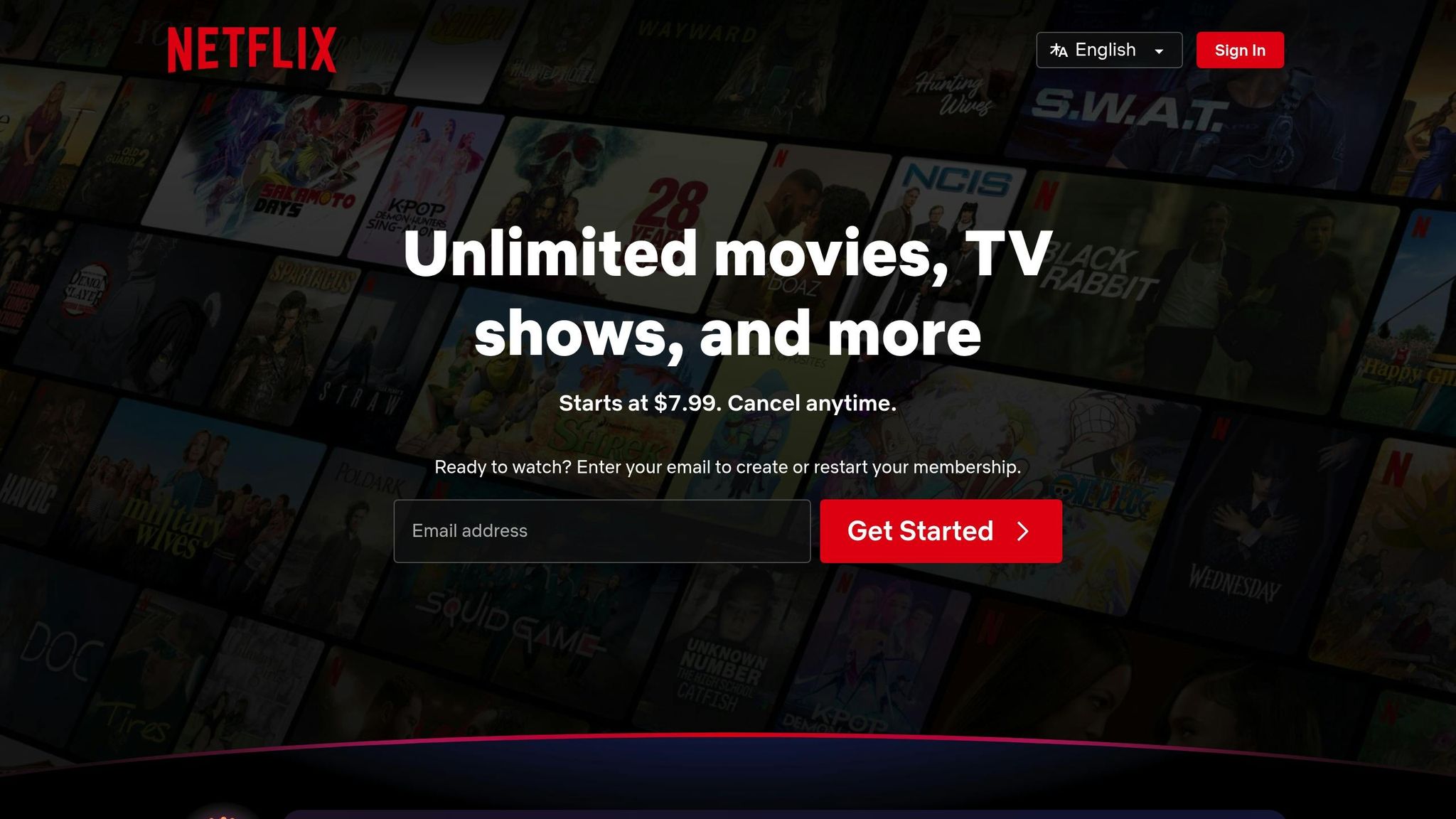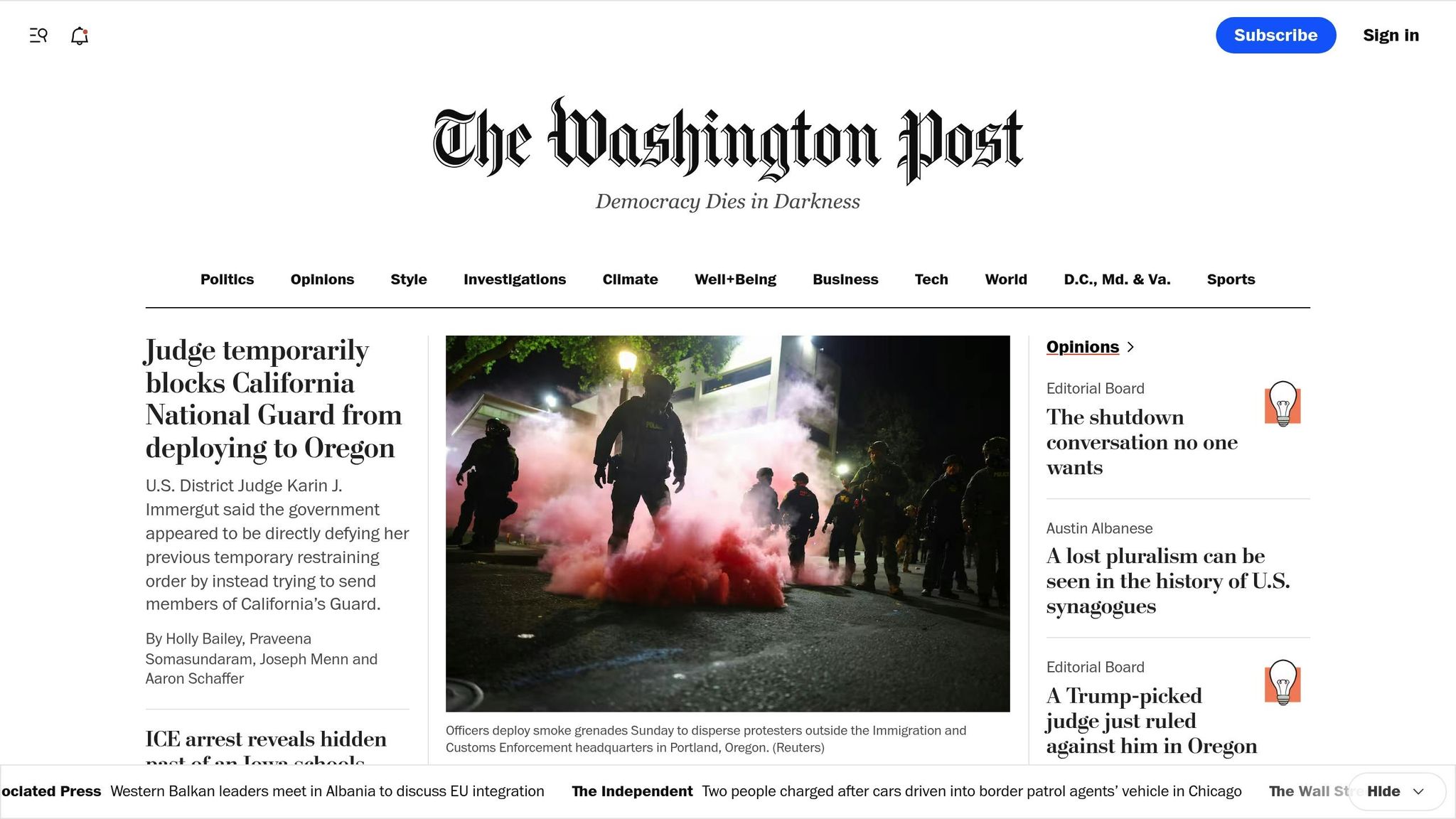Content automation is transforming how businesses create, manage, and distribute digital content. From AI-driven personalization to streamlined multi-channel management, companies are leveraging automation to save time, improve efficiency, and boost engagement. This article breaks down five examples of automation in action, highlighting key strategies and measurable results:
- Netflix: Uses AI for personalized thumbnails, increasing click-through rates by 20%-30%.
- The Washington Post: Automated news creation with Heliograf, producing over 850 articles during the Rio Olympics.
- Clark Rubber: Centralized content for 60+ stores, leading to a 20% revenue increase.
- AI in Newsrooms: Speeds up reporting by generating drafts from real-time data.
- Social Media & Email Automation: Improves engagement by optimizing content distribution timing.
These examples show how automation simplifies workflows, scales content, and enhances user experiences. Whether you're managing a global platform or local franchises, automation can help achieve measurable outcomes.
How a 2-Person Business Runs its Content System | AI Automation Case Study #1
Case Study 1: Netflix – AI-Driven Content Personalization

Netflix has mastered the art of using AI to make its platform feel uniquely tailored to each user. By leveraging advanced algorithms, the streaming giant customizes visual content - like thumbnails, banners, and previews - to match individual preferences.
How Netflix Makes It Work
Netflix doesn’t just rely on generic recommendations; it takes personalization to the next level with micro-personalization. Here’s how it works:
- User Behavior Modeling: Netflix tracks how users interact with visual elements, such as which thumbnails they hover over or click.
- Visual Content Analysis: Machine learning evaluates the appeal of different artwork, identifying which visuals resonate most with specific audiences.
- Personalized Ranking Algorithms: These algorithms decide which visual presentation will most likely grab a user’s attention. For example, someone who loves romantic comedies might see artwork emphasizing lighthearted moments, while a fan of thrillers might see darker, more suspenseful imagery.
By tailoring visuals based on viewing history and preferences, Netflix ensures that every piece of content feels more relevant to the viewer.
Results That Speak Volumes
Netflix’s approach to personalized content presentation has paid off in a big way. The company has reported a 20%–30% increase in Click-Through Rates (CTR) for many titles simply by optimizing the artwork. This boost in engagement not only helps users discover content they love but also plays a role in improving retention and overall satisfaction with the platform.
Case Study 2: The Washington Post – Real-Time Content Automation with Heliograf

In 2016, The Washington Post introduced Heliograf, a tool that redefined how newsrooms could handle large volumes of data-driven stories. By automating the creation of timely, accurate articles, Heliograf ensured that even the most data-heavy topics could be covered without overwhelming human reporters. This approach allowed for rapid publication while maintaining the newspaper's editorial standards.
How Heliograf Works
Heliograf is an NLG (Natural Language Generation) system that transforms structured data into human-readable news articles. Here's how it operates:
- Template-Based Writing: Editors design narrative templates that dictate the structure, tone, and style of the articles. These templates ensure that the automated stories align with The Washington Post's established voice.
- Data Integration: The system connects to structured data sources, such as sports databases, election results, and financial feeds. When new data becomes available, Heliograf processes it and generates stories on topics like election outcomes or sports scores in just minutes.
- Multi-Channel Distribution: Once an article is created, Heliograf formats and publishes it across various platforms, including newsletters, push notifications, social media, and the main website. This ensures that breaking news reaches readers wherever they are.
While automation drives efficiency, Heliograf doesn’t operate in isolation. It flags irregularities in data, allowing journalists to step in and handle more nuanced or complex stories.
Measured Results
The system's capabilities were put to the test during major events, such as the 2016 Rio Olympics. Over the course of the games, Heliograf produced more than 850 articles, covering everything from results and event summaries to athlete profiles. This level of output would have been unmanageable for human reporters alone, especially without compromising on quality or speed.
Case Study 3: Clark Rubber – Multi-Channel Content Management

Clark Rubber, a franchise with over 60 stores, faced a significant challenge: managing content, product information, pricing, and inventory seamlessly across its online platform and franchise locations. Their existing Shopify+ system wasn't equipped to handle the complexities of multi-store fulfillment or real-time inventory updates, which impacted both operations and customer experience.
Integrated Automation Setup
To tackle these issues, Clark Rubber partnered with Core dna to implement a fully automated eCommerce platform. This new system replaced their Shopify+ setup, addressing key operational hurdles.
The Core dna platform centralized content management, making it possible to automatically update product catalogs, inventory levels, and pricing changes across all 60+ stores at once. This eliminated the need for manual updates for each franchise location, saving time and reducing errors.
A robust POS integration ensured real-time inventory updates for each location, preventing overselling and maintaining stock accuracy across both online and in-store channels. The platform also introduced split ordering, automated multi-store fulfillment, and personalized customer portals. These portals allowed customers to track orders, view local inventory, and receive tailored recommendations, enhancing the overall shopping experience.
Previously, adding a new product required navigating complex workflows across multiple fulfillment partners and store websites. With Core dna's multi-site CMS, this process was simplified into a single, streamlined action, drastically improving efficiency and setting the stage for better business performance.
Business Results
The introduction of this automated system had a measurable impact on Clark Rubber's operations and revenue. The company saw a 20% revenue increase following the platform's launch, driven by improved efficiency and a better customer experience.
The unified platform consolidated operations for all 60+ stores, breaking down data silos and ensuring consistency for both customers and franchise owners. Store managers gained immediate access to real-time inventory data, pricing updates, and promotional materials, eliminating delays caused by manual updates from headquarters.
Operational efficiency improved dramatically. The Core dna team highlighted this transformation in their case study:
"Now, uploading a new product is not a complex workflow across 60 different fulfillment partners and sites. With Core dna multi-site CMS, it's a simple push of a button … That's the power of a great content automation platform."
The platform also enabled a seamless omnichannel shopping experience, allowing customers to start their journey online and complete it in-store - or vice versa - without encountering pricing mismatches or inventory issues. Personalized customer portals further boosted engagement and repeat purchases across the franchise network.
Additionally, automation reduced the administrative workload for franchise owners. Tasks that once required manual coordination between corporate headquarters and individual stores were streamlined, freeing up staff to focus on sales and customer service instead of time-consuming back-office tasks.
sbb-itb-5be333f
Case Study 4: AI-Powered News Reporting
The way newsrooms operate is changing, thanks to the growing role of AI in the reporting process. Major news organizations are now leveraging AI to speed up news production and distribution, making it easier to deliver updates in real time.
AI tools in newsrooms are designed to monitor social media, live feeds, and official announcements to identify breaking stories. Once a potential story is flagged, the system generates an initial draft, giving journalists more time to dive into in-depth analysis. This blend of automation and human expertise opens up a range of possibilities for how newsrooms manage their workflows.
How Automation Works in Newsrooms
AI-powered systems are particularly effective in covering breaking news. These tools scan vast amounts of data and social media platforms to identify major events as they unfold, enabling rapid reporting. They also handle routine updates, such as financial market summaries and sports highlights, ensuring consistent and timely coverage. Beyond that, AI can transform raw data - like meeting transcripts, public records, or other sources - into clear, reader-friendly articles. This makes it easier to cover local events and government decisions that might otherwise go unnoticed. Additionally, some systems analyze reader preferences to create personalized news feeds, connecting audiences with stories that align with their interests.
Key Advantages
The advantages of AI in newsrooms are hard to ignore. Around-the-clock operations mean news organizations can publish more stories and keep audiences engaged with timely updates and tailored content. By automating repetitive tasks, journalists are free to focus on investigative pieces and in-depth features, ultimately enhancing the quality and variety of the content they produce.
Case Study 5: Automated Social Media and Email Content Distribution
For modern businesses, manually managing content distribution across multiple platforms can feel like a never-ending time sink. That’s why many companies are now turning to automation platforms to simplify how they handle social media and email campaigns. These tools create smooth workflows that run continuously, ensuring a steady digital presence without constant hands-on effort. By moving from manual processes to automated systems, businesses can integrate tools more effectively and deliver content with greater precision.
Instead of relying on marketing teams to post content or send emails at random times, automation steps in to analyze audience behavior and schedule content for when it’s most likely to hit the mark.
Tool Setup and Integration
Setting up an automated content distribution system starts with linking various platforms through a centralized management hub. The leading tools in this space seamlessly integrate with existing content management systems and customer databases, creating workflows that are both efficient and unified.
These systems connect social media accounts and email lists to a single dashboard, where AI uses historical engagement data to determine the best posting times and test different headlines. As real-time data rolls in, the system fine-tunes its targeting, ensuring that promotional content lands with highly engaged followers while educational material reaches newer audiences still exploring the brand.
Cross-platform integration takes things a step further. For instance, a single blog post can automatically transform into social media updates, email newsletter highlights, and even personalized recommendations tailored to individual user activity. This kind of integration doesn’t just save time - it also delivers measurable improvements in how content performs across channels.
Performance Improvements
Companies that adopt automated content distribution often see noticeable boosts in engagement. Social media interactions, for example, frequently increase within just a few months of implementation. On top of that, automation reduces operational costs by freeing up marketing teams to focus on strategy and creativity instead of repetitive tasks.
Email marketing benefits significantly as well. Automated tools make it easier to run targeted drip campaigns that nurture leads more effectively than one-off manual emails. Whether it’s a welcome series, abandoned cart reminder, or re-engagement campaign, these processes are triggered by user behavior, leading to more consistent and predictable results.
Case Study Comparison
This section brings together key metrics and strategies from five case studies, highlighting how each company tailored its content automation approach to meet specific goals.
| Company | Platform/Tool | Primary Objective | Key Implementation Feature | Performance Outcomes |
|---|---|---|---|---|
| Netflix | AI-Driven Personalization Engine | Boost viewer engagement and retention | Leverages machine learning to provide personalized recommendations based on extensive viewing data | 20%–30% increase in click-through rates (CTR) |
| The Washington Post | Heliograf | Expand news production and coverage | Automates article creation for breaking news and sports events | Published over 850 articles during the Rio Olympics |
| Clark Rubber | Multi-Channel Content Management System | Simplify content distribution across locations | Centralized hub for distributing content to multiple retail outlets | Achieved a 20% revenue increase |
| AI-Powered News Organization | Automated Reporting Platform | Speed up news delivery | Processes data in real time to generate articles quickly | Enabled 24/7 operational capabilities |
| Multi-Platform Business | Social Media & Email Automation Tools | Improve content distribution timing | Analyzes audience behavior to optimize posting schedules | Increased engagement rates significantly |
Key Takeaways
- Implementation Timelines: Netflix took a gradual approach, refining its system over time, while The Washington Post rapidly deployed Heliograf during high-demand periods like major news cycles.
- Cost and Scalability: Investments ranged widely, from Netflix’s development of a proprietary system for a global audience to Clark Rubber’s more localized content coordination across retail locations. Each company aligned its system's complexity to its operational scale, ensuring efficiency.
- Human and Automation Balance: Across all examples, automation was paired with human oversight to ensure quality and relevance. This balance proved essential for scaling operations without compromising outcomes.
These case studies demonstrate that blending strategic automation with human input can effectively scale content distribution, whether for global audiences or niche markets.
Conclusion
The case studies above make one thing crystal clear: content automation delivers real, measurable benefits. From Netflix's AI-driven personalization to Clark Rubber's streamlined content management, automation has proven its ability to boost efficiency and audience engagement.
Netflix's use of AI for personalization and The Washington Post's automated reporting both stand out as prime examples of how automation can enhance performance. Meanwhile, Clark Rubber's centralized content strategy demonstrates how automation can directly contribute to revenue growth.
A key takeaway from these examples is that success often lies in striking the right balance between automation and human oversight. Whether it's fine-tuning processes over time or quickly adapting during high-demand periods, tailoring automation strategies to fit specific audience needs and business scales is essential.
For businesses of any size, automation can be a game-changer - if the tools are aligned with clear goals. If you're ready to take the leap, the Top SEO Marketing Directory offers a curated list of tools designed to meet a variety of needs. From content optimization and technical SEO automation to all-in-one digital marketing platforms, you’ll find expert recommendations to match your business goals and budget.
FAQs
How does Netflix use AI to enhance user engagement and keep subscribers?
Netflix uses AI-powered personalization to craft content recommendations that align closely with each user's tastes. This ensures viewers can easily find shows and movies that resonate with them, which naturally leads to longer watch times and keeps subscribers engaged.
Currently, about 80% of what people watch on Netflix is influenced by AI. These advanced algorithms enhance recommendation accuracy by roughly 42%, creating a viewing experience that feels tailored and enjoyable. This strategy not only boosts viewer satisfaction but also helps minimize subscriber cancellations, reinforcing Netflix's dominance in the streaming industry.
How does The Washington Post ensure quality in its automated news creation process?
The Washington Post blends automation with human expertise to uphold the high standards its readers expect. AI tools like Heliograf and Ember support tasks such as producing news updates and analyzing data. However, human editors and journalists remain essential in reviewing the content to ensure it meets strict benchmarks for accuracy, clarity, and quality.
This partnership between technology and human oversight allows The Washington Post to streamline processes while maintaining the trust and editorial integrity it’s known for.
How can businesses strike the right balance between automation and human input in their content strategies?
To strike the right balance between automation and human input, businesses should begin by pinpointing repetitive tasks that automation can handle effectively - think data analysis or generating basic content drafts. Automation is a great way to save time and boost efficiency, but it’s equally important to let humans step in for tasks like fine-tuning content, ensuring it reflects the brand’s unique voice, and adding that personal, relatable touch.
It’s also essential to regularly check automated content for quality and consistency. Incorporating customer feedback into this process helps keep the content relevant and builds trust. By blending the speed and efficiency of automation with the creativity and emotional insight that only humans can provide, businesses can craft content strategies that truly resonate.


